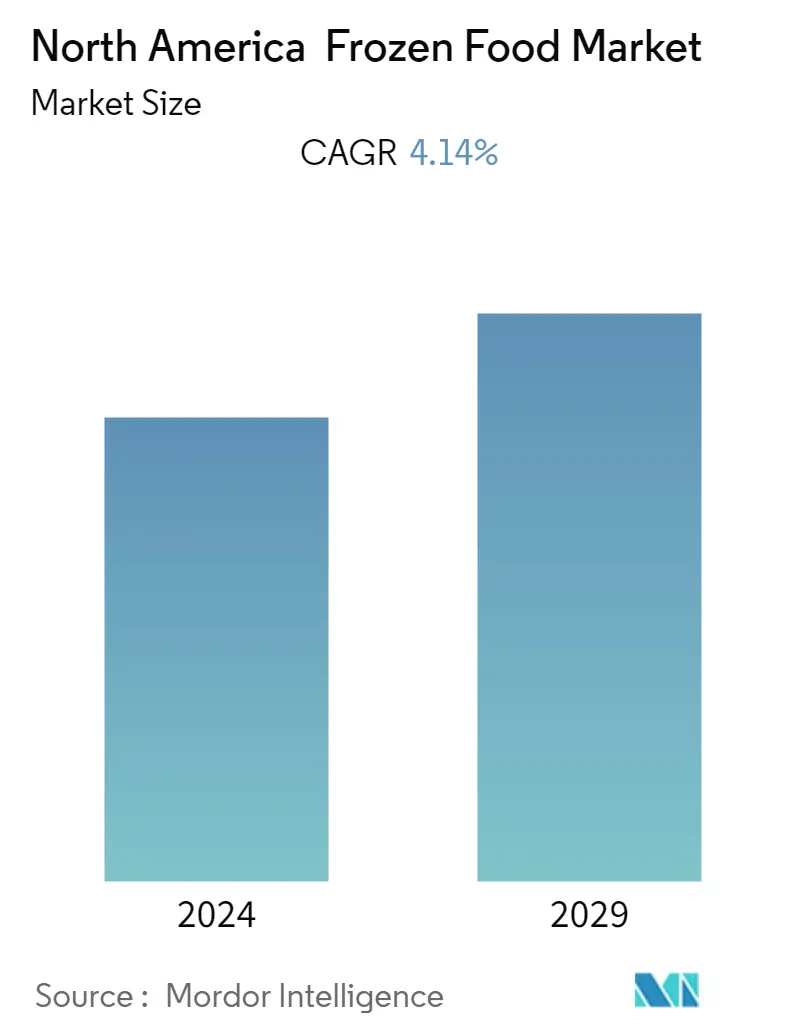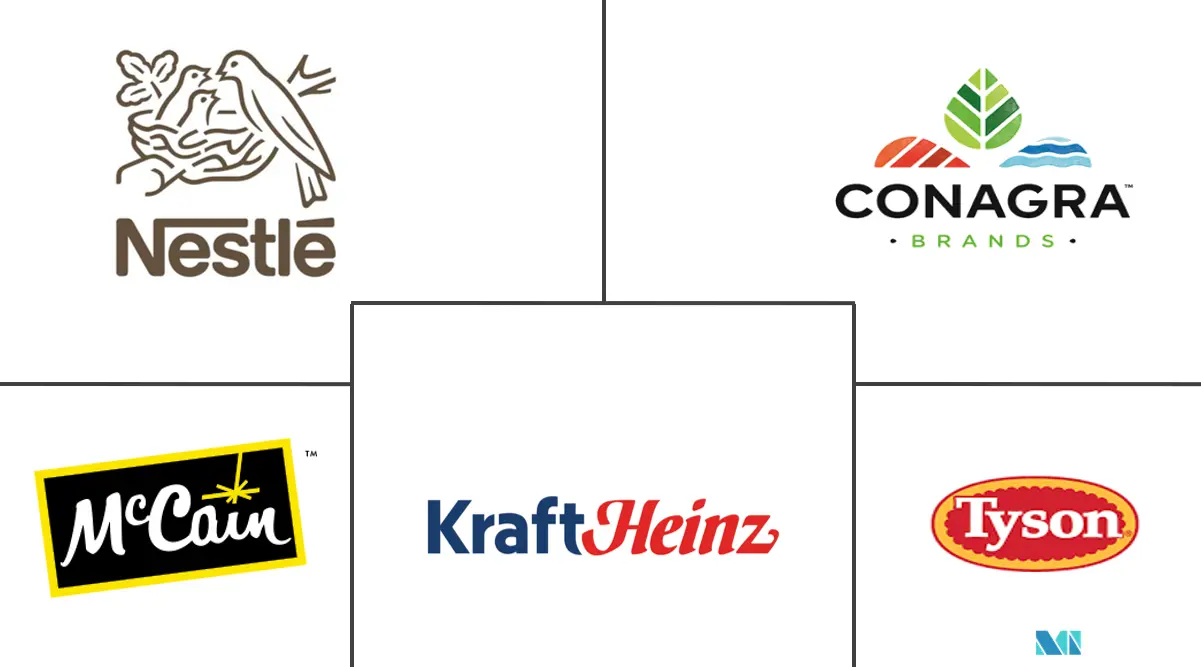Market Size of North America Frozen Food Industry

| Study Period | 2019 - 2029 |
| Base Year For Estimation | 2023 |
| Forecast Data Period | 2024 - 2029 |
| Historical Data Period | 2019 - 2022 |
| CAGR | 4.14 % |
| Market Concentration | Medium |
Major Players
*Disclaimer: Major Players sorted in no particular order |
North America Frozen Food Market Analysis
North America Frozen Food Market is projected to register a CAGR of 4.14% during the coming five years.
The growth of the North America Frozen Food Market is driven by the rising demand for convenient and ready-to-eat products, owing to the busy lifestyles and changing food-eating habits of North Americans. Innovative product developments, like low trans-fat, low fat, multigrain, whole wheat, and low-on-artificial-preservatives products, are expected to provide an impetus to the frozen food industry. The market is primarily driven by rising expenditure on food and beverage, the introduction of longer shelf-life products, increasing impulse purchasing, and huge demand for quick-preparation food due to the lack of cooking time catered with the convenience provided by frozen food products.
According to the US Department of Agriculture April 2021, 72.0% of Americans purchased frozen food due to their busy life schedules. These facts are likely to bode well with the market growth. The increasing health and safety concerns amid rising COVID-19 cases obligated people to take fewer trips to stores to buy household items, including food and snacks. Frozen food manufacturers are investing heavily in new technologies that are designed to make frozen foods more nutritious and last longer without the use of any preservatives. One such technology is pouch packaging. The airtight packaging keeps frozen foods fresh for longer by preventing any moisture, which would encourage bacteria and mold growth. It has another benefit of retaining more of the minerals and nutrients in frozen foods for longer and hence is a growing packaging trend in the country.
Moreover, owing to frozen food demand, manufacturers are focused on offering premium frozen meals in the market. For instance, in Febuary 2023, Nestle Canada enlarged the frozen meal aisle with its new launch called Marketplace Cuisine. As per Statistics Canada, consumer spending reached to CAD 1,227,135 million in the third quarter of 2022. Thus, the rising spending on premium-quality food products and the rising young population are the major factors driving the demand for convenient ready meals in Canada.
North America Frozen Food Industry Segmentation
Frozen food is defined as food products preserved under low temperatures and used over a long period. North America Frozen Food Market is segmented by product type such as frozen fruit and vegetable, frozen meat and seafood, frozen ready meals, frozen dessert, frozen snack, and others. On the basis of distribution channels, the market is segmented into supermarkets/hypermarkets, convenience stores, online retailers, and other distribution channels. Moreover, the study provides an analysis of the frozen food market in the emerging and established markets across the region, including the United States, Mexico, Canada, rest of North America. For each segment market size is provided in USD million.
| Product Type | |
| Frozen Fruit and Vegetable | |
| Frozen Meat and Seafood | |
| Frozen Ready Meals | |
| Frozen Dessert | |
| Frozen Snack | |
| Other Product types |
| Distribution Channel | |
| Supermarkets/Hypermarkets | |
| Convenience Stores | |
| Online Retail Stores | |
| Other Distribution Channnels |
| Geography | |
| United States | |
| Canada | |
| Mexico | |
| Rest of North America |
North America Frozen Food Market Size Summary
The North American frozen food market is experiencing significant growth, driven by the increasing demand for convenient and ready-to-eat products. This demand is largely attributed to the busy lifestyles and evolving food habits of consumers in the region. The market is witnessing a surge in innovative product developments, such as those featuring low trans-fat, multigrain, and whole wheat options, which are appealing to health-conscious consumers. The introduction of products with longer shelf lives and the growing trend of impulse purchasing are further propelling market expansion. The COVID-19 pandemic has also played a role in boosting the market, as health and safety concerns led to reduced store visits, prompting consumers to stock up on frozen foods. Manufacturers are investing in advanced technologies, like pouch packaging, to enhance the nutritional value and shelf life of frozen foods, catering to the rising demand for premium and plant-based frozen meals.
The market is characterized by a high level of competition, with numerous small and large players vying for market share. Major companies such as ConAgra Foods Inc, McCain Foods, and Nestle SA are actively engaging in strategies like product launches, mergers, and partnerships to strengthen their market position. The retail landscape, particularly supermarkets and hypermarkets, plays a crucial role in the distribution of frozen foods, offering a wide variety of products that attract consumers. Chains like Walmart and Kroger are leveraging loyalty programs to retain customers and drive sales. The trend towards smaller, more frequent meals and the preference for on-the-go food options are further fueling the demand for frozen foods in North America, making it a dynamic and rapidly evolving market.
North America Frozen Food Market Size - Table of Contents
-
1. MARKET DYNAMICS
-
1.1 Market Drivers
-
1.2 Market Restraints
-
1.3 Porter's Five Force Analysis
-
1.3.1 Bargaining Power of Buyers
-
1.3.2 Bargaining Power of Suppliers
-
1.3.3 Threat of New Entrants
-
1.3.4 Threat of Substitute
-
1.3.5 Threat of Competitive Rivalry
-
-
-
2. MARKET SEGMENTATION
-
2.1 Product Type
-
2.1.1 Frozen Fruit and Vegetable
-
2.1.2 Frozen Meat and Seafood
-
2.1.3 Frozen Ready Meals
-
2.1.4 Frozen Dessert
-
2.1.5 Frozen Snack
-
2.1.6 Other Product types
-
-
2.2 Distribution Channel
-
2.2.1 Supermarkets/Hypermarkets
-
2.2.2 Convenience Stores
-
2.2.3 Online Retail Stores
-
2.2.4 Other Distribution Channnels
-
-
2.3 Geography
-
2.3.1 United States
-
2.3.2 Canada
-
2.3.3 Mexico
-
2.3.4 Rest of North America
-
-
North America Frozen Food Market Size FAQs
What is the current North America Frozen Food Market size?
The North America Frozen Food Market is projected to register a CAGR of 4.14% during the forecast period (2024-2029)
Who are the key players in North America Frozen Food Market?
ConAgra Foods Inc, McCain Foods, Nestle SA, Tyson Foods Inc. and Kraft Heinz Co. are the major companies operating in the North America Frozen Food Market.

